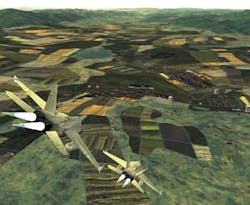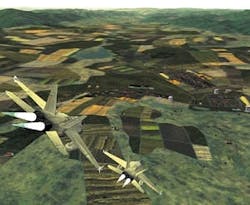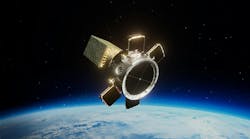By John McHale
SAN JOSE, Calif. — Officials at Silicon Graphics Inc. (SGI) are using MultiGen-Paradigm's Flight IG, a real-time image generation software for fast jet flight simulation as part of a solution for the F-15 jet fighter Flight and System Trainer, designed by engineers at Lockheed Martin Naval Electronics &#amp; Surveillance Systems in Akron, Ohio.
MPI's software will be installed in SGI's image generation hardware to form an integrated image-generator for the F-15 trainer, now in development at Akron for the Israeli air force.
"Flight IG represents one of the first systems that actually enables pilots to use night vision goggles, or NVGs, for night flight training, ultimately making them safer and more effective," says David Rolston, president and chief executive officer at MPI.
MPI's "FlightIG and database modeling products provide a cost effective, low-risk approach to deliver the highest performance image generation systems available today," says John Burwell, director of global programs for SGI.
Flight IG is built on MPI's flagship application Vega, designed specifically for fast, deterministic frame rates while rendering complex large area databases.
MPI engineers offer the fast jet solution in dome and flat-panel displays for SGI systems. The company's sensor simulation products create night-vision effects, such as halos around lights, and the scene darkening that occurs when a cloud obscures moonlight.
Sensor simulation is difficult because you have to simulate the exact console and insert different types of visual artifacts, then add the random noise and interference that occurs with aircraft sensors, explains Christian Cole, Vega product manager at MPI.
One of the main reasons that MPI engineers can create such detailed and deterministic graphics is because of the low-cost processing power available today, Cole says. A few years ago sensor simulation was not possible because the power needed was too costly, he explains. Now, with high-speed processing power available in low-cost, commercial-off-the-shelf (COTS) devices more realistic simulations can be achieved, Cole adds.
MPI engineers have also designed the software to generate visuals that are necessary for the pilot to see, thereby freeing up more processing power, Cole says. For example when a pilot is flying toward the horizon, once he passes over terrain and cannot see it anymore, the software will not generate the image, he explains.
In the future increased processing power will enable MPI engineers to increase the culture in the simulation, such as buildings, trees, and other little details, Cole says. Now only terrain and structures that are absolutely necessary are depicted, he adds.
Strong processing performance will also bring fine texture to simulation imagery, creating a realistic depiction of water and other effects, Cole says.
For more information on Flight IG and Vega contact MultiGen-Paradigm by phone at 408-261-4100, by mail at MultiGen-Paradigm, 550 S. Winchester Blvd., Suite 500, San Jose, Calif. 95128, or on the World Wide Web at http://www.multigen-paradigm.com.




